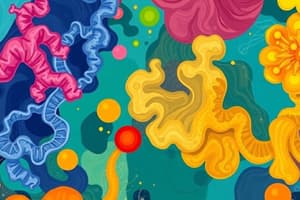Podcast
Questions and Answers
What defines the primary structure of proteins?
What defines the primary structure of proteins?
- The folding of alpha-helices and beta-sheets
- The aggregation of multiple polypeptide chains
- The arrangement of hydrophilic and hydrophobic R groups
- The linear sequence of amino acids in a polypeptide chain (correct)
Which of the following statements correctly describes quaternary protein structure?
Which of the following statements correctly describes quaternary protein structure?
- It is the aggregation of two or more polypeptide chains. (correct)
- It is the linear sequence of amino acids.
- It involves the folding of alpha-helices into beta-sheets.
- It consists of a single polypeptide chain in a globular shape.
Which type of protein is characterized by being extended and strand-like?
Which type of protein is characterized by being extended and strand-like?
- Membrane proteins
- Fibrous proteins (correct)
- Enzymatic proteins
- Globular proteins
What role do enzymes play in biochemical reactions?
What role do enzymes play in biochemical reactions?
Which R groups are located on the interior of a folded protein structure?
Which R groups are located on the interior of a folded protein structure?
What characterizes the tertiary structure of proteins?
What characterizes the tertiary structure of proteins?
Which of the following is a function of globular proteins?
Which of the following is a function of globular proteins?
What is the role of enzyme inhibitors?
What is the role of enzyme inhibitors?
Which type of protein is primarily responsible for providing structural support?
Which type of protein is primarily responsible for providing structural support?
In a protein's primary structure, what is the sequence made of?
In a protein's primary structure, what is the sequence made of?
Flashcards
Primary Protein Structure
Primary Protein Structure
The linear sequence of amino acids that make up a polypeptide chain.
Secondary Protein Structure
Secondary Protein Structure
The folding pattern of a polypeptide chain, forming either alpha-helices or beta-sheets.
Tertiary Protein Structure
Tertiary Protein Structure
The three-dimensional shape of a single polypeptide chain, formed by the interactions between different R groups.
Quaternary Protein Structure
Quaternary Protein Structure
Signup and view all the flashcards
Enzymes
Enzymes
Signup and view all the flashcards
What are proteins' primary functions?
What are proteins' primary functions?
Signup and view all the flashcards
How does protein structure relate to function?
How does protein structure relate to function?
Signup and view all the flashcards
What are the levels of protein structure?
What are the levels of protein structure?
Signup and view all the flashcards
What are fibrous proteins?
What are fibrous proteins?
Signup and view all the flashcards
What are globular proteins?
What are globular proteins?
Signup and view all the flashcards
Study Notes
Protein Structure
- Proteins are essential for structural support and diverse functions.
- Primary structure: A linear sequence of amino acids forming a polypeptide chain.
- Secondary structure: Alpha-helices and beta-sheets are common folded structures.
- Tertiary structure: Alpha-helices and beta-sheets fold to form a compact, globular shape. Hydrophobic R groups are often on the inside, and hydrophilic on the outside.
- Quaternary structure: Two or more polypeptide chains aggregate to create a larger structure.
Types of Proteins
Fibrous Proteins
- Structural proteins, elongated and strand-like in shape.
- Provide mechanical support and tensile strength in tissues.
- Example: Collagen.
Globular Proteins
- Functional proteins, compact and spherical in shape.
- Play critical roles in biological processes.
- Example: Enzymes
- Catalyze and accelerate biochemical reactions.
- Substrate binds to the active site, forming an enzyme-substrate complex.
- Internal changes within the complex form the products.
- Enzyme releases the product and returns to its original shape.
- Enzyme activity can be inhibited by molecules blocking the active site.
- Example: Nucleotides
- Examples are Cytosine, Thymine, Adenine, and Guanine.
Studying That Suits You
Use AI to generate personalized quizzes and flashcards to suit your learning preferences.



